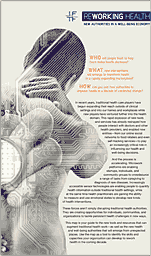Future Now
The IFTF Blog
Reworking Health: Translating Siloed Research into Medicine
As we finish this series on Reworking Health: New Authorities in a Well-being Economy, our final forecast—Translating Siloed Research into Medicine—is about the ever-popular potential for data analytics and cognitive computing to transform the way we research, track, and diagnose health and well-being.
The topic receives almost daily media coverage—from the incredible potential and dangers of data mining health records to how big data is changing the way we get well. Just this week The New York Times Magazine asks, "Can Big Data Tell us What Clinical Trials Don’t?"
For some perspective on why there is so much interest in creating technologies to support human decision-making, take a look at this graph from a recent TEDMED talk by Basit Chaudhry of IBM.
 On the vertical access is the number of clinical decisions required to take care of a person. On the horizontal access is time, out to the year 2020. This curve is exponentially increasing—but another important line to notice here is the horizontal yellow one at the bottom: human cognitive capacity, which isn’t changing at all. There is a huge and constantly growing gap between human cognitive capacity and the processing power really required to give patients the best care.
On the vertical access is the number of clinical decisions required to take care of a person. On the horizontal access is time, out to the year 2020. This curve is exponentially increasing—but another important line to notice here is the horizontal yellow one at the bottom: human cognitive capacity, which isn’t changing at all. There is a huge and constantly growing gap between human cognitive capacity and the processing power really required to give patients the best care.
To translate this science into the best medicine we will need productive interplay between artificial intelligence and human imagination. We cannot rely on algorithms to magically uncover all the paths to health and well-being. For example, “big data” missed the early warning signs of Ebola because it wasn’t “listening” in the right language.
Over the next decade, humans need to be more inquisitive than ever, develop fluency in multiple disciplines, ask hard questions, and constantly advance the creative search for new hypotheses.
One signal of using cognitive computing is IBM’s plan for a medical imaging assistant. Currently, physicians review thousands of x-rays, MRI’s, and ultrasound images to find the ones that are relevant. In the process, they might miss signs of disease they aren’t explicitly looking for. The computerized assistant will learn by examining millions of images along with the diagnoses, treatments, and outcomes associated with each of them. It could then translate that knowledge as it most relates to an individuals personal record or even family history.
Another group working on translating many disparate data sources into personalized medicine is Cancer Commons—an online oncology platform that pulls together new and relevant information from researchers, physicians, and patients to inform new standards of care.
I talked with its founder, Marty Tenenbaum, himself a melanoma survivor, and he described the 10,000 cancer-related clinical trials happening at any given time. But cancer is not a homogenous disease. It is thousands of unique molecular diseases, so in a randomized clinical trial the patients will have hundreds of different diseases.
If a clinical trial shows a treatment is 80% effective, what that really means is that is 100% effective for 80% of participants. This is a really important distinction if you are in that 20% minority for whom the treatment won’t work. So we need to re-think what we are measuring and how we are measuring it.
With the proliferation of wearable technologies and ubiquitous sensors, better integration of EMRs, and increasingly sophisticated analytics tools, we are seeing the early days of a transformation in how we support ourselves and each other in staying well.
At IFTF we are calling this future a Health Aware World—when the pills we put in our bodies connect to our homes and clinics to capture and deliver health information and the sensors and cameras embedded in our environments create comprehensive, continuous records of our health. In a Health Aware World our physical spaces “wake up” and engage communities to create better health outcomes. Responsive environments promote equity by supporting individuals, especially those who are unengaged or lack the resources to buy health gadgets.
Conference—November 12-13
If you’re interested in a hands-on exploration of life in a Health-Aware World, contact Dawn Alva (dalva@iftf.org or 650-233-9585) to learn how to attend our upcoming member-only event on November 12-13 at our Gallery for the Future in Palo Alto, CA. We will be exploring design parameters, technical foundations and the regulatory climate that will determine how we promote healthy living, fight disease, and support aging well over the coming decade.
In our 2013 Health Horizons research, Reworking Health, we examined four emerging sources of authority—computation, narratives, networks, and ambience—that will fundamentally transform who we trust and what interventions will be available in a rapidly expanding health and well-being marketplace.
This series of blog posts dives into the map's forecasts to reveal new opportunities and help you imagine what skills and capacities you or your organization can develop to rework health in the coming decade:
- Personalizing Space for Mindfulness
- Embedding Care Protocol Adherence
- Automating Media Therapy
- Amplifying the Positive
- Commoditizing Bodywork
- Optimizing the Care Effect
- Uncovering Empowering Identities
- Coordinating Caring Communities
- Calibrating Pain
- Contextualizing Science in Retail Settings
About IFTF's Health Horizons Program
- Contact Dawn Alva at dalva@iftf.org or 650-233-9585



